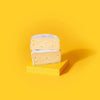Blue Cheese Buyer's Guide
By Claragh Nugent
Oct 5, 2021

Blue cheese, the great divider amongst fromage enthusiasts. Some can’t get enough, for some it’s just too much. Here at cheesegeek, we truly believe that if you don’t like a certain style of cheese, you just haven’t found the right one for you yet.
Aversion to styles of cheese, like blue cheese for example (goat’s cheese being another) is often because these higher moisture, usually younger cheeses are more susceptible to variation (and spoilage) than other styles. Higher moisture content, for example, when combined with the effects of blue veining, can lead to far more room for error, both during the make, but also during the transportation, storage and maturing phase. So when we get a sub-perfect blue cheese, it can often put us off blue cheese as a whole.
But without further ado, here is our buyer's guide to the big wide world of blue cheese, because it’s a truly wonderful world!
First up, FAQs about the blues.
Where did blue cheese come from?
Legend has it that a young shepherd seeking shelter in a cave was distracted by a beautiful girl so abandoned his lunch (a cheese sandwich of course!). When he returned to it months later, he had inadvertently created the first Roquefort (confusingly Gorgonzola has a very similar story attached to it). The mould penicillium roqueforti native to the cave had transformed his lunch into the first blue cheese! We think this one’s a bit of an old wives’ tale...how could someone be distracted from cheese?!
Why does blue cheese have veins?
These days, cheesemakers add penicillium roqueforti to their milk so that as the cheese matures, the mould can develop. They deliberately make sure their cheese has a very open texture to give the mould space to develop, and as it does, it forms the veins you see in blue cheese. The mould also needs one other crucial thing, a supply of oxygen. Makers achieve this by having open rinded cheese or by piercing the cheese (in Stilton, for example, this takes place at 5 weeks) which is why you often see small holes and blue veining growing linearly.
Why are lots of blue cheeses salty?
Salt is one method of controlling the growth of blue mould so you don’t end up with a cheese that's too blue. Salt can also help balance the flavour of the more picante or bitter notes creating a well rounded blue cheese. The flavour of ‘saltiness’ is also supplemented by a steely minerality that comes from penicillium roqueforti.
Your Bluestastic Buyer’s Guide:
For the “I don’t like blue”ers
We get it! Blue cheese can be a bit overwhelming. But we beg you, don’t discount all of them just yet. Take a look at what we affectionately term beginner blues.
Bluemin White (Shepherd’s Purse) -
This little trucklett is a brie style cheese with one big difference from most blues that you'll see...the blue mould develops only on the outside of the cheese! This means no scary blue veining and the subtlest of blue tang that compliments the creamy inner texture. Your perfect gateway into the world of blue!
Binham Blue (Mrs Temple’s Cheese) -
How can we describe Binham? It’s like a salted caramel hug. A buttery, luxurious texture with ALL the rich, umami flavours and none of the bitter notes. An absolute treat for blue and non-blue lovers alike!
For the “on the fence”ers
You’ve had a dolcelatte and quite enjoyed it, maybe Gorgonzola on a pizza on that trip to Tuscany? But blues would never be your first choice and you’d probably skip on the cheese board. These blues will have you hopping over the fence into the big blue world.
Cashel Blue (Cashel) -
Oh so heavenly, endlessly creamy Cashel is just the blue you’ve been looking for. With notes of honey and hazelnut, it has a blue, salty tang but doesn’t linger on the pallet. This blue is the perfect step up in your repertoire.
All of the mild creaminess of a gorgonzola with a hint of spice that you’d expect from a Stilton. Beauvale is the perfect hybrid that gives a taster of more gutsy blues, in the comfortable setting of a rich creamy texture. Winner!
For the “preaching to the converted”ers
You’re a fully blown blue believer. You go straight for the Stilton at Christmas! We know you need no convincing, so here are some showstopping blues to knock your socks off!

Stichelton (Stichelton Dairy)-
Arguably the truest, most traditional ‘Stilton-style’ cheese in production, Stichelton is made using raw milk to a traditional recipe. The untouched flavours of the milk give Stichy complex caramel notes that perfectly balance it’s punchy blue tang. One of the keys here is the much later piercing and longer maturation, which allow so much more flavour development of the milk.
Northern Blue (Shepherd's Purse) -
Shepherd’s Purse use a stronger strain of roquefort mould to give Northern blue an intense blue kick. This is balanced by the rich, buttery cow’s milk that provides a creamy texture that’s unforgettable.
So if you’re just dipping a toe or you’re bluemin mad, there’s a blue out there for everyone!
And finally, what do we at CG HQ look for in a great blue cheese?
Well the key is all of the flavours that are not directly related to the blue veining (slightly ironically!). Creaminess, fruitiness, umami, all those layers of flavour that are enhanced, not dominated by the blue. This shows a cheese that has allowed the milk to sing, as well as the moulds. Interestingly, with blue cheese, unlike hard and soft cheeses, made and matured correctly, they can mellow with age, becoming smoother, and more rounded and balanced. Take Rogue River Blue, for example, 2019 Supreme Champion Cheese, it is matured for 1 year! Almost unheard of for a blue cheese!!


